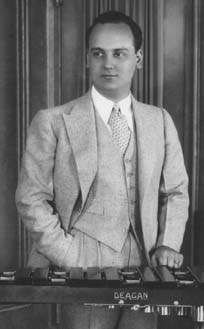Sammy Herman
by Dana Kimble and James A. Strain
 Sammy Herman was New York's first-call xylophonist for radio, television, recordings and live performances for over forty years. As the xylophonist for the NBC studios in New York from 1928 to 1966, his career spanned the "golden age" for both the xylophone and radio, and ushered in the age of television.
Sammy Herman was New York's first-call xylophonist for radio, television, recordings and live performances for over forty years. As the xylophonist for the NBC studios in New York from 1928 to 1966, his career spanned the "golden age" for both the xylophone and radio, and ushered in the age of television.
When Sam Herman's name is mentioned, words of praise come from everyone who ever heard him. Red Norvo recalls, "He helped me get started in New York. We later played together in the large dance orchestras of that time. He was truly at the top." Gordon Stout affirms that, "Sammy Herman is one of the greatest xylophonists in our history. Performing with him at PASIC '87 was an extremely special and memorable moment in my musical career."
Regarding his amazing technique, Herman reflects, "As a lefty, I was able to play the melody in the left hand and the harmony notes in the right hand. I didn't approach the instrument from a technical aspect, I just played the best music I could, noodling wherever I thought it was appropriate, letting my ear guide me."
Born May 7, 1903, in Bronxwood Park, New York, Samuel Herbert Herman began his music study at the age of eight, first with piano lessons from his mother, who demonstrated sheet music at Macy's department store, and later with Charles K. Hambitzer, who was also George Gershwin's teacher. Brief lessons from an uncle who was a drummer with the Army band led to his participation in his high school orchestra, where his first performance on xylophone was Saint Sains' "Danse Macabre."
From that day forward he had to have an instrument. Herman recalls his first xylophone: "It was a beautiful instrument - a Deagan model 870. I later found out that my grandmother had agreed to pay half so that she would not have to hear me pestering my father anymore."
While still in high school, he began performing for local dances and in small clubs. A chance encounter by pianist Phil Ohman resulted in his "discovery" and acceptance into the society bands of New York.
Herman's career began to blossom when he landed a job with the Paul Specht Orchestra at the Hotel Alamac in New York City. It was here that Broadway producer Earl Carroll heard Sammy and asked him to play in Earl Carroll's Vanities. For the next year (1923-24) Sammy played with the Specht band from 5:00 to 7:00 p.m., then rode the subway two stops downtown to start Vanities by 8:00 p.m. When the show let out around 11:00 p.m., he would ride the subway back uptown to begin dance sets with the Specht band by 11:30 p.m.
Also during this time Herman began playing radio dates on station WEAF with the Phil Ohman Trio. After the Broadway run of Vanities, Sammy went on the road with the touring show for two years (1924-25). Upon his return he auditioned for the job of instrumental soloist with the Eight Popular Victor Artists. Henry Burr, the leader, was not too fond of xylophone, but after hearing Sammy play offered him the job. The next two years (1925-26) were spent touring and recording for the Victor Company.
After his return to New York, Herman spent two years freelancing. In 1928 he signed on with the National Broadcasting Company Artist Service as the first xylophonist, at a starting pay of $750.00 per week. For some of the top artists in radio the depression was not even felt.
As a staff musician at NBC, Sammy associated with the "Who's Who" of popular music from the 1920s, '30s and '40s, including Al Jolson, Paul Whiteman, Bing Crosby, Frank Sinatra, the Dorsey Brothers, Benny Goodman, Harry Breuer, Red Norvo, Joe Green, George Hamilton Green, Jr., Billy Dorn, Fred Albright, Charlie Daab, George Gaber and dozens of other famous musicians. An autographed picture of George Gershwin hangs in Herman's music room, as does a copy of his first commercially released record, "Al Fresco," recorded on the Victor label in 1927 with pianist Frank Banta.
As radio gave way to television, Sam was featured on programs such as the Lucky Strike Orchestra and Hit Parade, Paul Whiteman's Band broadcasts, Shell's Chateau Hour, the Major Bowes Capital Family Hour, Waltz Time, Manhattan Merry-Go-Round, The American Melody Hour, Tic-Tac-Dough, "21", Concentration, Yours For a Song, Let's Play Post Office and his own show, The Herman and Banta Show. For many of these shows Sammy was a weekly featured soloist, and after a ten-year run of his own daily show, Sammy Herman and Frank Banta were household names.
It is impossible to document all of Herman's work, which includes radio and television dates, recordings, concerts and society dates. To quote Sam, "I never stopped working in those days. First would be recording dates early in the morning, then a radio program in the afternoon and I would often play society jobs all night long."
Sammy retired from NBC in 1966, having been the first xylophonist hired and the only one left at the end of an era. His career spans from the early 1920s to PASIC '87 in St. Louis, a performance that Herman describes as "one of the nicest times I ever had."
Sam's numerous arrangements for xylophone are still played today, and no performer can adequately understand the popular style from his era without a close examination of Herman's recordings and publications. According to Bob Becker, "Sammy was the consummate xylophone performer during an era that produced many legendary players. In both technical skill and improvisational abilities he was unmatched."